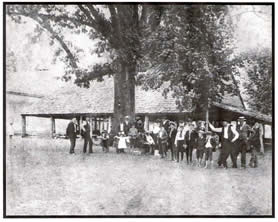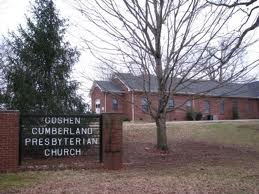 |
|
The History of Goshen Cumberland Presbyterian ChurchBy: L. Jarod Pearson
Goshen Cumberland Presbyterian Church, located near Cowan above Boiling Fork Creek, is Franklin County's first organized church and played a major role in the pioneer settlement of the area. In 1808 Rev. Gideon Blackburn, a Presbyterian minister, organized the first church on Goshen hill. Most of the pioneer settlers in Franklin County were Scotch-Irish immigrants from Ulster Plantation (now known as Northern Ireland) and most had a Presbyterian faith history. Of course, there were no churches in the area at the time of his arrival. The religious practices of families in the American frontier involved prayer and scripture reading at home. Then, on occasion and maybe once per year, a minister of the gospel would visit and hold camp meetings so that families for miles around could hear preaching, receive the sacraments, and break bread with fellow believers. Camp meetings grew in popularity and importance as part of the Second Great Awakening, a revival movement that swept pioneer settlements and even the established churches in New England. Rev. Blackburn was a product of this great revival.
The influence of the Second Great Awakening on Presbyterianism in America is critically important to the history of Goshen. Unlike their Methodist and Baptist brethren, the Presbyterian establishment in the United States was divided on its view toward the revival movement. Old School Presbyterians placed a huge emphasis on the formal education of ministers. That emphasis made it difficult for Presbyterians to respond quickly to changing demographics, namely the vast population growth in the American frontier. Another related issue was the fact that ministers who were trained at Princeton and other prestigious institutions were less inclined to brave the wild frontier. Cumberland Presbytery, a geographical body of the Presbyterian Church in the United States, responded to the urgent need for ministers by ordaining a group of men to preach and administer sacraments without a full theological education. Some of these men also opposed certain elements of the Westminster Confession of Faith by embracing a more Armenian theology of "whosoever will". Kentucky Synod of the Presbyterian Church refused to recognize the newly ordained ministers, and voted to dissolve Cumberland Presbytery. In response to those actions, three ministers from the former Cumberland Presbytery - Rev. Finis Ewing, Rev. Samuel King, and Rev. Samuel McAdow - met Rev. McAdow's home in Dickson, Tennessee and organized the Cumberland Presbyterian Church. The meeting took place on February 4, 1810. Rev. Samuel King was among the ministers who helped organize the first camp meeting revival at Goshen in the Year 1810. A brush arbor was built for holding the services and a camp ground developed to house the visiting families. Revivals at Goshen were usually held in the month of August consisting of powerful church services, singing, instruction, meals, and fellowship. Literally hundreds of people, including area slaves, were baptized in the first few years of the annual camp meetings. Some 13 men who attended services at Goshen in the first two decades entered the ministry of the Cumberland Presbyterian Church. Rev. Robert Bell was installed as the first pastor of the newly organized Goshen Church and the first five Elders were: James Keith, John Cowan, James McCord, William Alexander, and Benjamin Wear. The original church structure was built with logs and served also as a pioneer school for the area. A permanent brick church building was finally constructed in the Year 1844 to replace the log structure. Written memoirs from the church tell conflicting stories about what became of this particular church building. The general consensus is that it was destroyed during the Civil War along with the campground cabins as Union soldiers stayed on the camp ground an entire winter. Others claim that the church building survived the Civil War, albeit with some damage, and was used until a wood-frame replacement was built shortly after the war. In post Civil War years, Goshen grew to a more traditional church setting. The camp ground was never replaced; however, a new brush arbor was constructed in 1865. The church building was used for services year round except when August revivals came around and the church met at the arbor. By the early 20th Century the pastor of the church was a stipendiary position. In 1949 the congregation undertook a massive building and growth program. By 1952 a modern new brick structure was built with helpful contributions of money and labor from the church membership and extended family. This building stands today having received with several updates and one significant expansion. Goshen Cumberland Presbyterian Church continues the tradition of August revival meetings, though these days they last a few nights as opposed to a few weeks. The adjacent Goshen cemetery contains some of Franklin County's oldest graves with names of pioneer families still well-known in Franklin County. The church membership still consists of prominent founding families, namely the Cowans, Knights, and Williams, among others. As Franklin County's first organized church and as one of the first churches in the Cumberland Presbyterian denomination, history is alive and well at Goshen!
Source: "History of Goshen Church", prepared by Hazel Money Cowan for the Golden Jubilee Celebration held on May 8, 1960.
|

